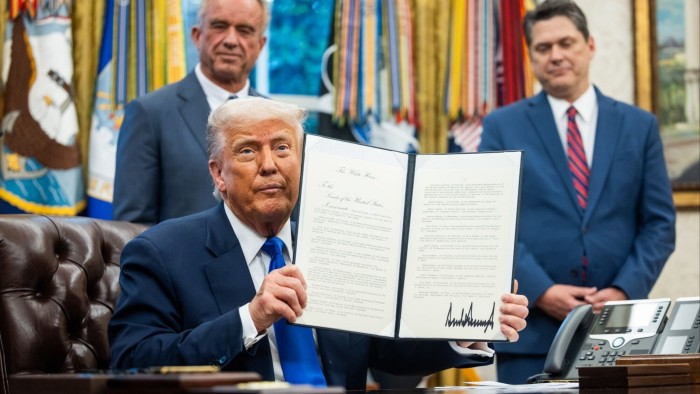Unlock the White House Watch newsletter for free
Your guide to what Trump’s second term means for Washington, business and the world
“You get what you pay for” has a nice ring to it. But it does not accurately describe the situation of those buying prescription pharmaceuticals in the US. President Trump, who has vowed to lower drugs prices by as much as 80 per cent, may finally have found a useful target for his sledgehammer.
Drug prices have been a long-standing headache for successive US administrations. The complex system through which private insurers and state programmes buy pharmaceuticals means they pay a multiple of what comparable products cost in other countries.
In 2022, gross prices — before discounts and rebates — were 2.8 times as high as those in 33 OECD comparison countries according to a study by Rand Corporation. That falls to 1.7 times including estimated discounts and rebates.
Prescriptions to address this differential have so far proved ineffective. Trump tried — and failed — to lower prices in his first term. Whether his latest executive order — which the White House said would “communicate price targets to pharmaceutical manufacturers” and cut out intermediaries — will deliver concrete results remains to be seen.
Pharma companies will squeal. And with good reason. The US is by far the biggest market for prescription drugs, accounting for roughly $600bn of annual sales out of a global $1tn or so. Huge US companies — think AbbVie, Eli Lilly and Pfizer — derive between 70 and 90 per cent of their sales from it, according to Berenberg analysis. Europeans such as AstraZeneca, GSK and Sanofi are less exposed, but with 40-50 per cent of sales into the US they are hardly immune to this malady.

Yet it is hard to see a strong public policy justification for such costly US drugs. It is true that developing new therapies is a hit and miss endeavour, which requires the prospects of juicy returns for the winners. Less clear is why the US should shoulder such a disproportionate share of this burden. Indeed, a less lucrative US market might strengthen the hand of drugs companies in their negotiations with European national health services, meaning costs are more evenly shared out.
The US does derive some benefit from its position as the leading market for drugs. Biotech companies are mostly US based, and global drugmakers tend to seek a US license for their compounds before that of any other country. Conversely, with a penny-pinching National Health Service, England ranks sixth in the European rankings for new medicine availability, behind Germany, Italy, Austria, Switzerland and Spain. Yet the US has a thriving ecosystem, and a big market. There is probably quite a lot that it could do to cut the profit pool before innovation takes a nosedive.
If Trump did find a way of lowering US prices, it would be bitter pill for global pharmaceutical companies to swallow. The side effects and — in medical terms — interactions are uncertain. But based on the patient’s current condition, this blunt approach looks merited.
